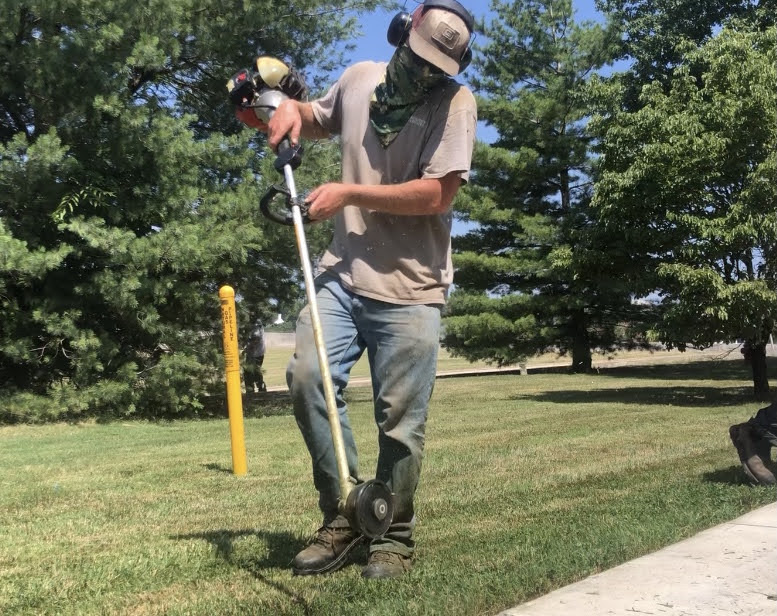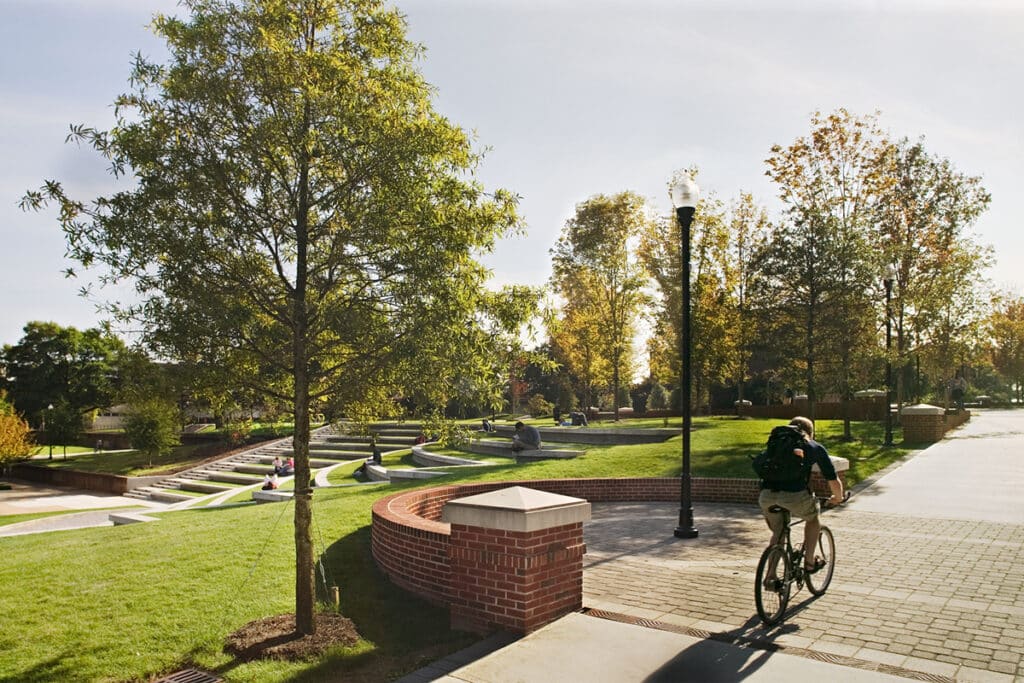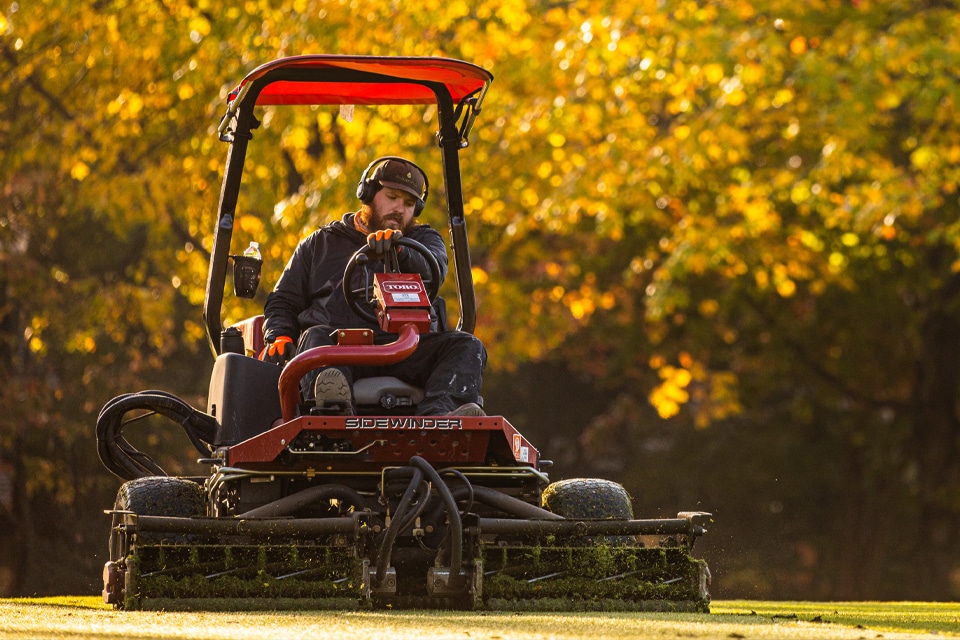Story by: Ella Kelley, FS Communications Student Assistant
After a cold winter on campus, the days are getting longer and the number of classes left in the spring are dwindling. As spring showers fall and temperatures rise, the Facilities Services Turf Management team is prepared to shine.
Small but mighty, the Turf Management crew is tasked with managing 50 acres of turf on campus and 50 acres at other university-owned properties.
Year-Round Commitment
The goal of Turf Management is to create a peaceful environment in the middle of a city. They aim to achieve a country atmosphere that softens the concrete jungles to make everyone on campus feel at home.
Each season looks a little different for Turf Management. In the time leading up to spring, mowing foremen Austin Nicely and Jackie Wheat lead their teams in preparation. They are currently making pre-emergent herbicide applications, which involves throwing out fertilizer and treating and feeding the grass.

“It’s giving a feed to start it, basically, and killing anything that might be getting ready to or to prevent it from germinating, like a weed, clover, or something like that,” Nicely said.
Spring/Summer Mowing Season
They’re planning for a busy mowing season, which isn’t limited to cutting grass and trimming weeds. These crews use this time to place sod where needed and to reconstruct where vehicles, pedestrian activity, and events damaged grassy areas in the fall.
During the busy season, most areas on campus are mowed up to twice a week. That’s up to 100 acres every seven days, but let’s put that in UT terms. This kind of coverage is equal to mowing Shield-Watkins field in Neyland Stadium 75.6 times in a week!
Turf Management also emphasizes the care of event lawns like Circle Park as showpieces on campus. Cole Gonzales is the turf specialist tasked with the care and keeping of these special spaces. Event lawns feature a different type of grass better suited for high traffic areas and are subsequently managed differently. Campus has roughly 3.5 acres of event lawns which are typically mowed three times per week.
Focus on Fall
In the fall, they primarily focus on leaves and maintaining the grass from the summer. Leaf management becomes a big task with 9,200+ trees across campus. Crews use leaf vacuums to manage leaves from October until early February.

During the fall, they also prepare the grass for the winter weather. This is particularly important for the event lawns, as the foot traffic and tailgating during football season continuously damages the grass every fall.
“With the football season, they have tents up, so all that wear and tear from all the foot traffic can have a pretty detrimental impact on the lawns,” Gonzales said.
After football season ends, Turf Management overseeds the lawns to allow the grass to recover from the damage done. Without taking these precautions, the grass will go dormant upon the first frost. To avoid this, Turf Management overseeds these areas with ryegrass to keep campus lawns green year-round.
Turf Manager Curtis Pique said, “the problem is, we are introducing competition to that Bermuda grass with the ryegrass, and then we’re also beating it down to the dirt right as it’s going into its hardest time. We’ll put the ryegrass out, they’ll have two or three more games, and they kill all of that, then we have to do it again. But by that time, it’s gotten so cold that even the ryegrass has a hard time germinating. So it really takes until about February for all that seed to get back out.”
Winter Project Work
Winter is a slower season because grass stagnates or goes dormant when the temperatures drop. As it gets closer to spring, Turf Management typically has to re-sod the event lawns altogether before they enter mowing season.
Turf Management works tirelessly to maintain the lawns to their standards. Tennessee is in a geographical transition zone, meaning it is too far north for warm season grasses and too far south for cool season grasses. Because of this, Turf Management has a lot to contend with. It takes hard work, time, and dedication to keep campus lawns up to their standards, but they get the job done.
Maintaining Standards
These standards are largely influenced by the American Physical Plant Association (APPA) which provides guidelines for educational facilities management. APPA is an organization that provides resources and programs for facilities professionals. They have a system for judging the level of attention necessary for proper grounds maintenance at institutions. Level one is referred to as “state-of-the-art maintenance applied to a high-quality diverse landscape” and is “associated with high-traffic urban areas, such as public squares, government grounds, or college, university, or school campuses.” Level two is referred to as “high level of maintenance” and is “associated with well-developed public areas, malls, government grounds, or college, university, or school campuses.”

“On average, we maintain our entire campus to the level two,” Pique said. “So, grass is cut at least once a week, good fertilization plan, good weed control plan, irrigated turf.”
Some of the lawns on campus require level one maintenance, like around the Student Union, Ayres Hill, and the event lawns.
“It takes an army to keep that where it needs to be,” Pique said. “We have 12 people that do nothing but mow every day, mow, line trim, edge and blow.”
This crew takes great pride in how their work helps beautify campus, and they believe their attention to detail is what sets our campus apart. Everything they do must be done with meticulous care and attention to detail to ensure that the campus looks its best. People may not always notice the good things that landscaping does, but they notice when it is not done well. That is why Turf Management works tirelessly to maintain their high standards for the turf and landscape across campus.
“We take a lot of pride in it, and these guys do a great job at that,” Pique said.
Everyone on campus sees what Turf Management does, so it is important to them that their job is done well.
“I was given the old adage when I was in the golf course business. A guy comes into the golf pro shop for five minutes. He’s in that office for five minutes, but he’s in our office for four and a half hours. It’s the same kind of thing. They’re in class for their hour, hour and a half, but they’re in our office moving between classes the entire day,” Pique said.
To learn more about the Turf Management team and Facilities Services, visit our Operations.

